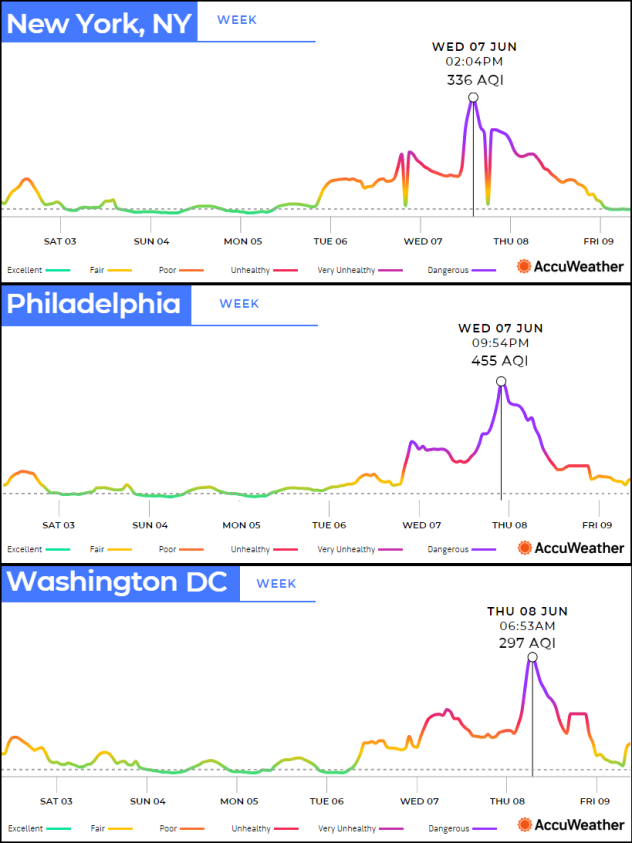Northeast not out of the woods yet even as air quality improves
Air quality levels were slowly beginning to improve across the Northeast at the start of the weekend following days of smoke-filled skies, but with the fire season just starting, the region might not be out of the woods just yet.
A red sunrise over New York City on Wednesday served as an ill omen for what was to come for the remainder of the week as wind steered smoke from Quebec's wildfires into the United States. By Wednesday afternoon, the smoke had shrouded the city in a dystopian orange haze and aggravated the lungs of those who ventured outside.
"You can't even see the Statue of Liberty today, and usually it's bright and clear," Jack Wright, a retired lawyer in New York City, told AFPTV on Wednesday. He added that while he had quit smoking 50 years ago, while outside, he had started to experience a similar cough as when he had smoked.
The raging wildfires in Quebec combined with steering winds from the combination of two weather systems were the main factors at play during the week, funneling the smoke into the eastern U.S., according to AccuWeather meteorologists.
"The combination of a stalled high pressure system over the northern Plains and a stationary low pressure system off Atlantic Canada produced a persistent steering wind from north to south across the region, which sent thick plumes of smoke southward into the Northeast, Middle Atlantic and Ohio Valley," AccuWeather Senior Meteorologist Brett Anderson explained.
He added that as these fires were largely in remote, wooded areas, they would likely continue to burn into the summer as most of Canada's firefighting efforts were focused on saving homes and property.
New York City, Philadelphia and Washington, D.C., were among the cities with some of the worst Air Quality Index (AQI) levels throughout the week, with the former two earning the unwanted title as cities with the world's worst air quality for a time.
The air quality levels at all three cities reached "dangerous" levels on Wednesday, the highest level on the six-level scale by Plume Labs, which is owned by AccuWeather. Philadelphia had the worst air quality level on Wednesday night with an AQI of 455. New York City had an AQI of 336 on Wednesday afternoon and Washington, D.C., had an AQI of 297 on Thursday morning.
 |
New York, Philadelphia, and Washington, D.C. air quality readings for the week of June 3-9. |
The hazardous air took its toll on several aspects of daily life, forcing people to reevaluate how to go about life while protecting themselves from the smoke. New York City public schools held remote instruction on Friday to prevent students and staff from venturing outdoors, and several Broadway shows were canceled Wednesday evening. This included the shows such as "Hamilton" and "Camelot."
Tonight's performance of Hamilton will not go on as scheduled. The hazardous air quality in New York City has made it impossible for a number of our artists to perform this evening. Shows will resume as scheduled tomorrow. We apologize for the inconvenience and encourage you to...
— Hamilton (@HamiltonMusical) June 8, 2023
The White House's Pride event, which was scheduled to take place on the South Lawn on Thursday evening, was postponed until Saturday due to the smoke from Canada's growing fires.
By Thursday morning, the amount of land burning in Quebec from the wildfires was the size of Delaware, according to Anderson.
"For Canada, the amount of acres burned through early June has already surpassed the 10-year average for an entire season," he said. "We are not necessarily seeing more fires with climate change, but larger fires that are consuming vast amounts of area."
After a dry May, Quebec and Nova Scotia have set new seasonal records for the amount of land burned during a wildfire season, according to Anderson.
The smoke filling the New York skies that the record-breaking wildfires generated has also been unprecedented, according to Basil Seggos, commissioner of New York's Department of Environmental Conservation (DEC). In an interview with AccuWeather Assistant Chief Broadcast Meteorologist Geoff Cornish, Seggos said the amount of smoke seen in the state was "unlike anything we've seen."
To find a similar event, Seggos told Cornish that he had to look back over 50 years ago to when smog in the New York City area led to the deaths of about 168 people. "What it [the smoke] has impacted from New York state, now all the way down to Washington, D.C., there hasn't been anything like this impacting such a large population in decades," Seggos said.
 |
A man wears a face mask as smoke continues to shroud the sun as it rises behind the skyline of Manhattan in New York City on June 7, 2023, as seen from Weehawken, New Jersey. (Photo by Kena Betancur/VIEWpress/Getty Images) |
The next similar event was in 2002 when wildfires in the Canadian provinces impacted New York, but he added that "it was nothing like this," as smoke from the 2002 event wasn't as widespread or persistent as the smoke over the past few days.
The smoke in the Northeast won't stick around for long, according to AccuWeather meteorologists. However, they also warned that more smoky spells are possible in the near future and can occasionally occur throughout the summer months in the Northeast.
That includes the second half of this week as winds blowing from the north could give fires in Canada a second wind and direct the smoke back over the Northeast. While air quality levels likely won't be as bad as they had been over the past few days, they could still reach health-threatening levels.
Want next-level safety, ad-free? Unlock advanced, hyperlocal severe weather alerts when you subscribe to Premium+ on the AccuWeather app.AccuWeather Alerts™ are prompted by our expert meteorologists who monitor and analyze dangerous weather risks 24/7 to keep you and your family safer.




